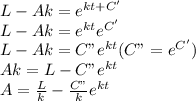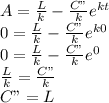Answer:
D = L/k
Explanation:
Since A represents the amount of litter present in grams per square meter as a function of time in years, the net rate of litter present is
dA/dt = in flow - out flow
Since litter falls at a constant rate of L grams per square meter per year, in flow = L
Since litter decays at a constant proportional rate of k per year, the total amount of litter decay per square meter per year is A × k = Ak = out flow
So,
dA/dt = in flow - out flow
dA/dt = L - Ak
Separating the variables, we have
dA/(L - Ak) = dt
Integrating, we have
∫-kdA/-k(L - Ak) = ∫dt
1/k∫-kdA/(L - Ak) = ∫dt
1/k㏑(L - Ak) = t + C
㏑(L - Ak) = kt + kC
㏑(L - Ak) = kt + C' (C' = kC)
taking exponents of both sides, we have

When t = 0, A(0) = 0 (since the forest floor is initially clear)


So, D = R - A =

when t = 0(at initial time), the initial value of D =
